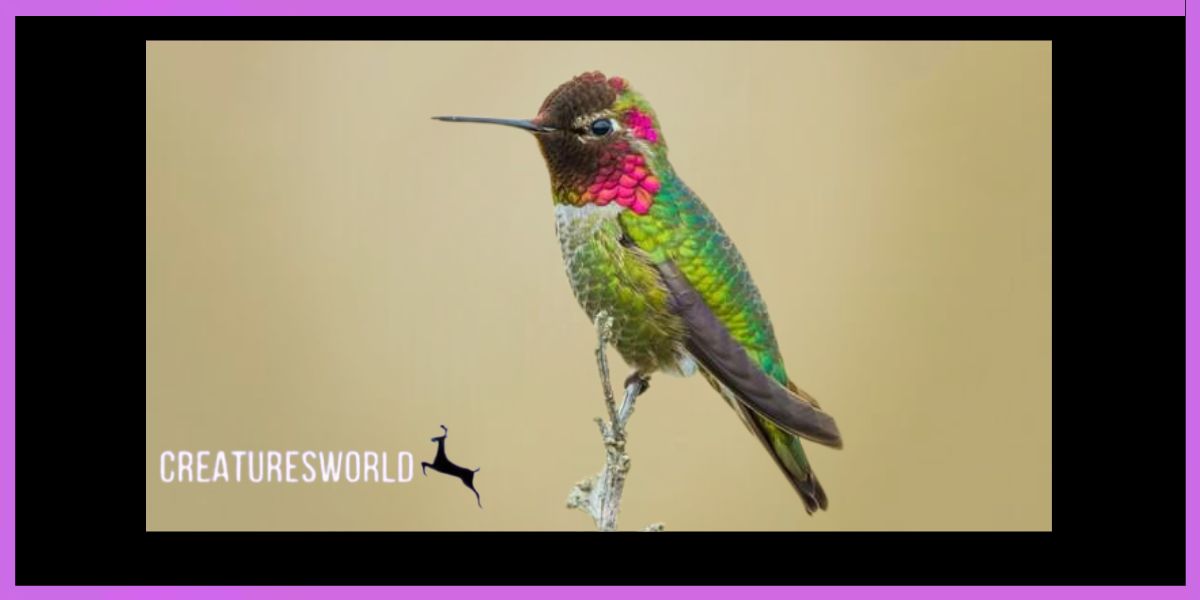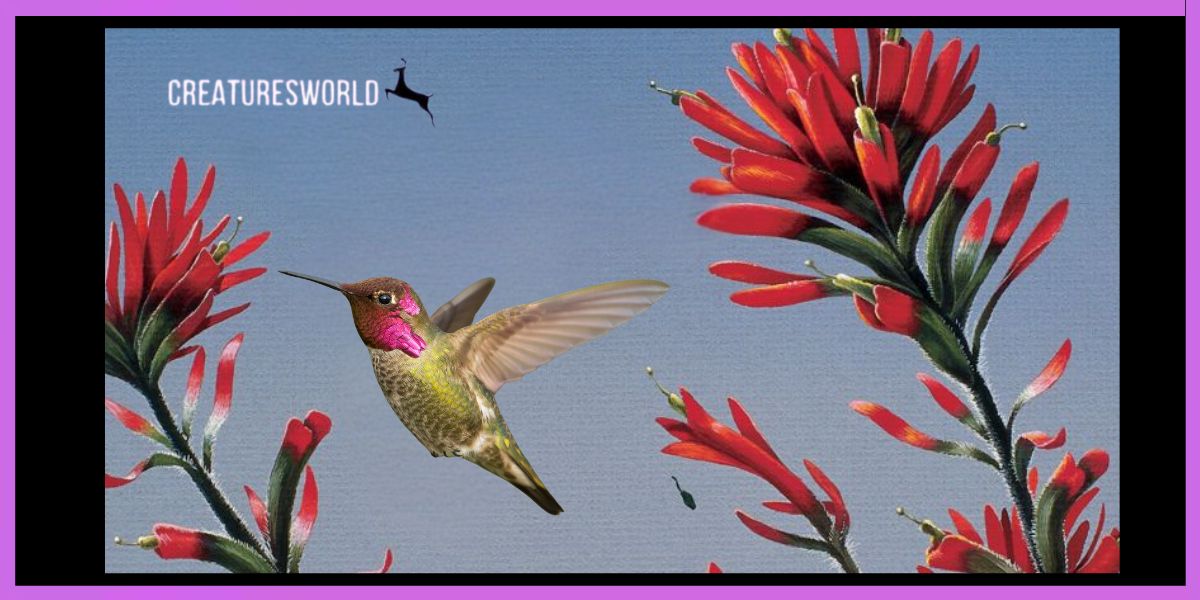The Anna’s Hummingbird scientifically known as Calypte anna, is one of the most common hummingbirds.
Anna’s Hummingbird Physical Characteristics
Despite being only 3.9 inches (10 cm) long and weighing about the same as a paperclip (around 4 grams), Anna’s Hummingbird is easy to recognise.
Males wear a dazzling gorget and crown that shines hot pink to magenta when sunlight hits it at just the right angle. Females are less colourful but still beautiful, with greenish backs, white bellies, and a small patch of red on the throat. Both sexes have metallic green feathers on their backs and sides, giving them a jewel-like shimmer.
It’s not just their look that makes them unforgettable — it’s how they move. They’re like stunt pilots in the sky, capable of hovering in place, flying backward, and zipping in all directions with lightning speed.
The Dive Display Anna’s Hummingbird Firework Show Reproduction
Imagine this: a male Anna’s Hummingbird flies about 100 feet into the sky, pauses for a second — and then dives straight down at breakneck speed. Just before hitting the ground, it suddenly pulls up, creating a sharp chirp caused by air rushing through its tail feathers.
This dive isn’t random. It’s part of his dramatic courtship ritual. It shows off his strength, precision, and shimmering feathers to any female watching. Sometimes he even loops upward in a U-shaped arc, showing off his iridescent gorget as he climbs and dives again.

These displays aren’t just beautiful — they’re deadly accurate. Researchers have found that Anna’s Hummingbirds reach speeds of up to 60 miles per hour during the dive and experience forces over 10 Gs — more than what jet pilots face. All this, from a bird the size of your thumb.
Anna’s Hummingbird Habitat
Anna’s Hummingbirds thrive in open woodlands, coastal scrub, gardens, and urban backyards along the western coast of North America, from southern Alaska through California and into northern Mexico.
Read about The latest News of Dire Wolves Being Back?
Anna’s Hummingbird Metabolism Diet
Anna’s Hummingbirds have one of the highest metabolisms in the animal kingdom. Their hearts can beat over 1,200 times per minute, and their wings flap about 50–80 times per second. To power that kind of energy, they need to feed almost constantly — sipping nectar from flowers and feeders.
But nectar isn’t enough. They also eat small insects and spiders for protein, especially during breeding and nesting. This makes them essential pollinators and tiny pest controllers at the same time.
compared to popular belief, they do not suck syrup like a straw; rather, they use their long, extendable tongues to drink it up. A capillary effect generated by the tongue’s dividing and wrapping brings liquid in at a rate of about 13 times per second.
Anna’s Hummingbird Behaviour
Don’t be fooled by their size. The Anna’s Hummingbirds have a strong sense of territoriality. Males will chase other birds away from their favourite flowers or feeders, including larger birds like crows or jays. They have a reputation for aggressive chirping, dive-bombing intruders, and defending their territory like little fighters.
Males can become particularly aggressive during the breeding season, patrolling their area nonstop and going for any female that flies close by.
They are territorial even in areas where people are present. A single Anna’s Hummingbird has taken over an entire feeder station and scared away all other visitors, according to numerous backyard birdwatchers.
Anna’s Hummingbird Facts
These hummingbirds can see beyond the spectrum visible to humans, detecting ultraviolet colors that help them find flowers and navigate their environment.
During courtship displays, males perform dazzling dives reaching speeds among the fastest recorded for any bird their size.
 Unlike most hummingbirds, Anna’s Hummingbird is the only species in North America known to produce a true song, a scratchy yet complex melody used to attract mates and defend territory.
Unlike most hummingbirds, Anna’s Hummingbird is the only species in North America known to produce a true song, a scratchy yet complex melody used to attract mates and defend territory.
To survive chilly nights, they can enter a state called torpor, lowering their body temperature and slowing their metabolism to conserve energy.
Their eggs are no larger than a coffee bean, carefully placed inside a walnut-sized nest woven from plant fibers, spider silk, and camouflaged with lichens.
While many hummingbirds migrate long distances, Anna’s Hummingbirds have adapted to remain in their habitats year-round, even enduring winters along the Pacific Coast.
Their hearts can beat over 1,200 times per minute, requiring them to feed almost constantly on nectar, insects, and spiders to sustain energy.
They can hover in place, fly backward, and even upside down for short bursts, thanks to their unique wing structure that rotates in a full circle.
Anna’s Hummingbird Conservation
Anna’s Hummingbird is listed as Least Concern by the IUCN, with populations growing thanks to their adaptability to gardens, parks, and cities. Still, they face threats from habitat loss, climate change, and pesticides. Planting native flowers and avoiding chemicals helps ensure their survival.
Everything I ( I, Kabir Thakur) have written here is thought out and well research processed Information, As soon new news come out about them I will update as soon as I can. Please comment me for your doubts and to correct me if I am wrong.

